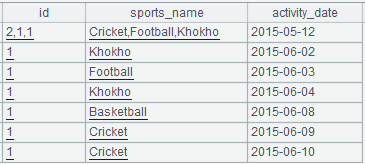Two-level Grouping & Concatenation
【Question】
I have one table called ‘activity_data’, which contains the following fields: id (int(11)) , sports_name (varchar(20)), activity_date (datetime)
Here’s information of activity_data table:
id sports_name activity_date
1 Cricket 2015-05-12
2 Football 2015-05-12
3 Cricket 2015-06-10
4 Basketball 2015-06-08
5 Khokho 2015-06-02
6 Kubbdi 2015-06-04
7 Cricket 2015-05-12
8 Kubbdi 2015-05-12
9 Cricket 2015-06-09
10 Football 2015-06-03
Now I’m executing the following queries:
SELECT GROUP\_CONCAT(id) id ,GROUP\_CONCAT(DISTINCT(sports\_name)) sports\_name,activity_date
FROM filter\_activity\_data
WHERE activity_date BETWEEN '2015-05-12' AND '2015-06-04'
GROUP BY activity_date
ORDER BY activity_date ASC
Output is like this:
id sports_name activity_date
1,2,7,8 Cricket,Football,Kubbdi 2015-05-12
5 Khokho 2015-06-02
10 Football 2015-06-03
6 Kubbdi 2015-06-04
… …
I want to get total count of each GROUP_CONCAT sports_name. Expected output is like this:
id sports_name activity_date
2,1,1 Cricket,Football,Kubbdi 2015-05-12
1 Khokho 2015-06-02
1 Football 2015-06-03
1 Kubbdi 2015-06-04
… …
【Answer】
SQL solution:
select GROUP_CONCAT(t.name1) as name2 , GROUP_CONCAT(t.count) as counts , t.activity_date from
(SELECT GROUP\_CONCAT(id) id ,GROUP\_CONCAT(DISTINCT(sports_name)) as name1 , count(*) as count , sports\_name,activity\_date
FROM activity_data
WHERE activity_date BETWEEN '2015-05-12' AND '2015-06-04'
GROUP BY activity\_date, sports\_name
ORDER BY activity_date ASC) as t
group by t.activity_date
There’s a more concise solution with the same algorithm. It is the SPL (Structure Process Language) solution, as shown below:
| A |
|
| 1 |
$select * from activity_data |
| 2 |
=A1.groups(activity_date,sports_name;count(~):c) |
| 3 |
=A2.group@o(activity_date).new(~.(c).concat@c():id,~.(sports_name).concat@c():sports_name,activity_date) |
A1: Retrieve data in SQL;
A2: Perform grouping and count over the records;
A3: Concatenate records of all groups. Here’s the final result:

SPL Official Website 👉 https://www.scudata.com
SPL Feedback and Help 👉 https://www.reddit.com/r/esProc_SPL
SPL Learning Material 👉 https://c.scudata.com
SPL Source Code and Package 👉 https://github.com/SPLWare/esProc
Discord 👉 https://discord.gg/cFTcUNs7
Youtube 👉 https://www.youtube.com/@esProc_SPL


